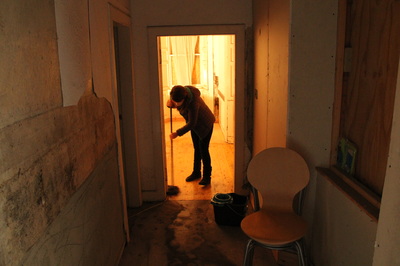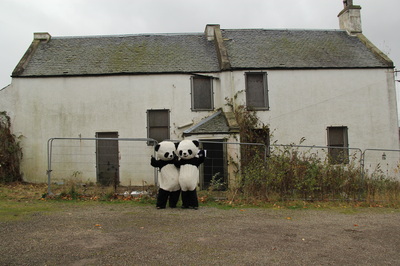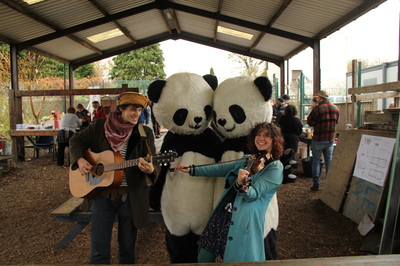|
Another year has passed and another beautiful autumnal day was spent under the Bridgend Growing Communities' barn. But this time we were not meeting under unknown circumstances... with petitions demanding 'Bridgend Farmhouse for the community', talking of hopes and visions as hypothetical dreams. This time we gathered in celebration! With the keys to the farmhouse, at long last we were able to show people inside. Wearing hard hats, small groups were led around the downstairs to see the space and start visualising what could physically happen within.
Meanwhile outside the farmhouse people listened to the sweet songs of Gillywolfe, had tours of the BGC gardens, feasted on hot vegetable soup and homebaked bread and made owl crafts. Later on we had a consultation workshop where groups started exploring what the 'learning, eating and exercise centre' meant to them and discussed shared values and aspirations for the farmhouse. Passionate voices were raised; jubilating the potential of community-ownership amidst a landscape of privatisation, the importance of encouraging outdoor learning and activities in this computer age. Thank you all those who came along to show your support and share your ideas, thoughts and visions. Thank you also to those who brought homebaked cakes to share! All these little gestures make such events memorable.
1 Comment
 BIG were recently asked to contribute to Glasshouse Design's Thinkpiece series in response to the question 'Does practice make perfect in Place?'. A summary of the article is published here or for our thoughts in full read on.....
Preface This article aims contextualise the issues of our experiences at Bridgend Inspiring Growth, within the framework of broader issues of placemaking and community-led development. It supports the concept of people as instrumental to effective use of places and space. In this way, it can help shed light on a more holistic view of place. What is Placemaking? Placemaking is a multi-faceted approach to the planning, design and management of public spaces. Placemaking, both as a process and a philosophy, capitalizes on a local community's assets. This includes a project’s wider inspiration, and potential, with the intention of creating public spaces that promote people's health, happiness, and well-being. It is political due to the nature of place identity. There is a shift in our emphasis today to involve communities in the process of deciding what they want and need and often with local people taking responsibility for delivering the end results themselves. Community empowerment, asset transfer and land reform are slowly influencing how places are created and/or regenerated; through consultation and consensus local decisions are arrived at and implemented. What are the aims of, and issues faced by Bridgend Inspiring Growth? Bridgend Inspiring Growth (BIG) is a local voluntary group supported by contracted professionals working towards the development and restoration of Bridgend farmhouse, Edinburgh, to become a community-owned and led multi-purpose space to promote sustainable living practices and outdoor learning. These dual allied aims help root the development of the project in social and socially sustainable aims and outcomes. The path faced by community-led development teams is seldom a smooth one, though issues like the recent advent of the Community Empowerment Bill in Scotland and Community Asset Transfer mechanisms are helping change the landscape for the better. Regards BIG’s journey, in the Spring of this year councillors at City of Edinburgh Council Economy Committee overturned a previous recommendation and voted unanimously to lease Bridgend Farmhouse to BIG for 12 months, and agreed to sell the farmhouse to BIG after that period, on confirmation of BIG Lottery Growing Community Assets Stage 2 funding. BIG is now at the stage of appointing an architect as lead building professional to take the project to statutory planning approval, alongside Business plan development work by a Project Management team. This means the project will be both financially viable as a build and economically sustainable as a built project, as it continues to the construction of capital build stage, pending submission of a successful Stage 2 Lottery funding bid. How does BIG specifically engage the community in placemaking? BIG has been drawing on community input as a generation for ideas for the built environment and landscape for the development project, as well as the securing of the property, from the start of the project. In this way, the on-going process of the making of the place has had the community element embedded into its design philosophy and evolution. An initial design feasibility study by Malcolm Fraser architects built on the core values of the place from the project visioning, as founded on the three core functions of learning, eating and exercise. These will be used as a foundation for informing the programmatic use of spaces within the detailed design brief in the concept design stages. Aspirations regard the building end-uses and users have been much more than words from the outset. BIG has engaged the community in a series of participatory design workshops as well as over a dozen publically-funded extra-curricular classes based around all these core activities, run by a dedicated community development worker. BIG’s project is at an interim stage in its development, and the role of the community will be central at all stages. What conclusions can be drawn for the role of community groups in placemaking and strengthening communities and their assets? Given the complexities inherent in placemaking as an ideology and practice, it is inevitable that testing is necessary to get it right. Housing developments and town centres tend to have little community input to their design and operation, and token processes to engage local people and potential users. In BIG’s case, rather than tick-box exercise or afterthought, community engagement is an integral part to shaping the place via its input into both the design process and the eventual function and use of the building. Considered use of the community as a resource for both the process and philosophy of a build project is key to its establishment as a successful, socially sustainable place. Short-termism, quick fixes and the satisfaction of short-term goals or financial rewards are barriers to holistic thinking. There are arguments that communities, often generating their own financial resources, are more sustainable custodians of the future of their local places in that they will be there for the duration rather than the next political term or priority. Written by Sandra Macaskill (CaskieCo) and Yasmin Ali 26.10.2014 The writers are working on BIG’s project as part of the Business Development Project Management Team led by CaskieCo. CaskieCo is a community development agency that works with community groups to acquire assets and develop community enterprises. Yasmin Ali is a freelance architectural & urban designer and journalist. Since those jubilant scenes outside the Council offices in April we’ve been busy making our vision for Bridgend Farm House a reality. We’ve been negotiating the terms of the “licence” under which the Council is “giving” us the building for a year while we draw up detailed plans for the farm house and its projects.
The Big Lottery has been very supportive and we have won stage-one funding to allow us to employ consultants to prepare architectural plans, apply for planning permission, engage a part-time project manager and consult with the community and potential farm house users. We have now drawn up formal tender documents and are looking at bids from professional consultants. We hope to have everything in place by the spring of next year to be able to apply for full funding from the Lottery. This will allow us to acquire the building, restore it, install a community kitchen and café and build a series of out-houses on one side of the garden. Meanwhile, our community worker Hilary Morrison has been making good use of a Council grant to run no fewer than 13 projects, ranging from cookery classes, to forest fun days, eco-gardening, walking groups and heritage events. We were intrigued to see an archaeological dig taking place at the farm house in June organised by the Greater Liberton Heritage Project and funded by the Heritage Lottery. The dig lasted a week and uncovered yet more evidence that the site was originally a chapel built by Sir Simon Preston in 1518. It’s very likely therefore that Mary Queen of Scots worshiped here while she was staying at Craigmillar Castle in 1566. By 1792, the chapel was referred to as “stables” and by 1850, the Ordnance Survey map was showing it as a “ labourer’s cottage.” So we have a long and interesting heritage to protect and enjoy. |
BIG BLOGThis blog is an archive of older posts that was kept up to date by the BIG board. For blog posts prior to July 2014 go here
November 2014
Categories |
- Home
- Get Involved
-
Our Media
- Video Gallery >
-
Publications
>
- Forms and Resources
- The Story of BIG >
- Our Queen's Award
- Community Consultation 2020-21
- Bridgend Past and Present
- Annual Report 2022
- Annual Report 2021
- 2020 AGM
- COVID-19 Food Resilience Response Project final report
- A community-led emergency response to food precarity
- Senscot Bulletin May 20
- healthandcarescotland May 20
- Bellacaledonia May 20
- ScotsMag
- HolyroodMagazine
- Our Journey
- Our older documents >
-
General Archives
>
|
Proudly powered by Weebly
|

































 RSS Feed
RSS Feed


